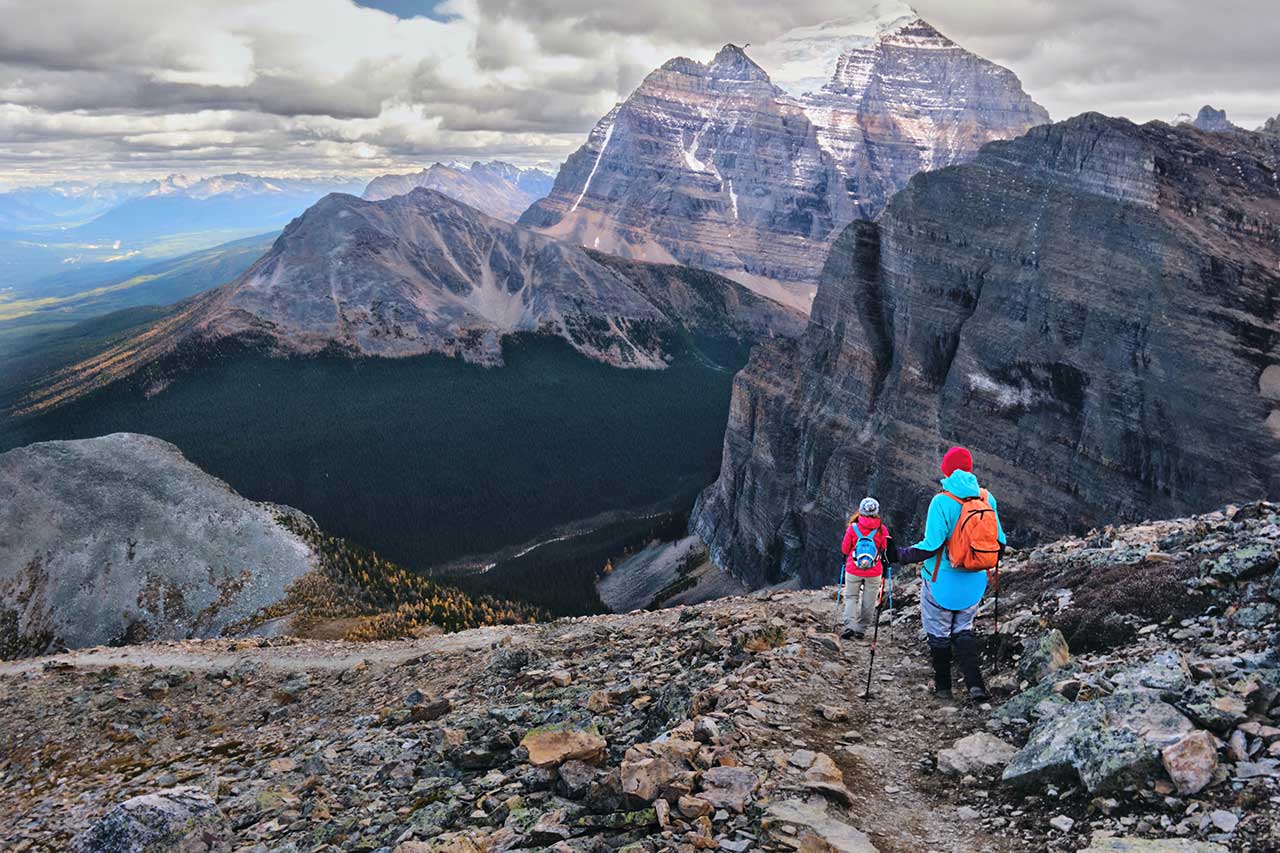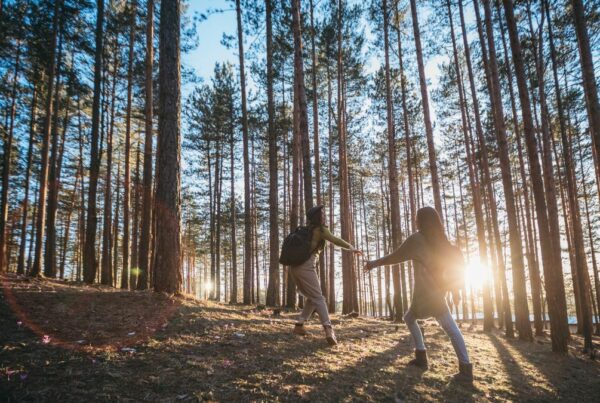Here’s a fun and playful exercise for practicing mindfulness in nature on your next mindful hiking adventure.
It’s called the 5-4-3-2-1 Technique and it’s an easy way to shift out of the mode of analytical thinking and start to mindfully immerse yourself in your senses.
When I lead mindful hiking adventures I often start with this mindfulness practice because it’s an easy way for people to shift out of the busy-minded thinking of normal life in the city and shift into mindful sensory immersion in the beauty and wonder of the natural world.
Want to lead to facilitate your own mindful hiking adventures? Join the next cohort of our Mindful Hiking Guide and Experiential Learning Facilitator Certification.
Start With Mindful Breathing
First, you want to do a simple deep breathing exercise called the 4-8 method to slow your mind down and feel more relaxed and present.
To do this, breathe in for 4 seconds through your nose, hold your breath briefly at the top of the breath and then breathe out slowly through the mouth for 8 seconds with puckered lips like you are breathing through a straw.
When you do this for a few minutes you will slow down your breathing rate to about 5 breaths a minute, which will turn off the high alertness of your sympathetic nervous system (the stress response) and turn on the open awareness of your parasympathetic nervous system (the relaxation response).
This mindful breathing practice can be done while standing, sitting or walking — whichever you prefer.
Once you do this breathing technique, you will notice you are feeling more relaxed, which means that mindfulness will come much more naturally once you start hiking.
Using The 5-4-3-2-1 Mindfulness Technique

Once you have done the 4-8 breathing technique and slowed down your breath, try practicing the 5-4-3-2-1 technique as you begin mindful hiking.
This mindfulness technique is a fun and playful way to ground yourself in your senses. When practicing it, try to notice small details that your mind would usually tune — such as the distant horizon, the tree canopy above you or the detailed textures of flowers or plants.
1. What are 5 things you can see?
Start by observing what you see around you. Let your curiosity guide you as you walk and notice what grabs your attention. Look up at the sky, down at the ground and through your peripheral vision to get a different perspective.
See if you can notice 5 things that are particularly fascinating to you. It could be the vastness of the blue sky, the branching fractal shape of trees, birds flying around or animals you notice moving in the forest.
2. What are 4 things you can touch?
Explore how your body feels the world around you by noticing things like the sensation of your feet on the ground, your clothing on your body and the sun’s warmth on your skin. Gently touch objects that grab your attention like rocks, tree bark, moss or flowers noticing how their texture feels to touch.
Pay attention to how your surroundings make you feel. Notice how the vastness of the sky can fill you with a subtle sense of awe and appreciation. See if you can identify four things in your environment that feels particularly good to your touch.
3. What are 3 things you can hear?
Now shift your attention to listening to the sounds around you. Bird songs, trees blowing in the mind, the distant hum of traffic, the sounds of footsteps on the ground or faraway voices or animal sounds that carry on the wind.
Stop for a moment, close your eyes and bring your full attention to the sounds that your mind usually tunes out. Let yourself become one with the sounds, notice how they make you feel and any emotions they evoke within you.
4. What are 2 things you can smell?
Explore your sense of smell by taking a few deep breaths through your nose. Breeze in the fresh oxygen from the trees and notice if you can smell any specific scents you only notice when hiking in nature.
Notice the subtle fragrances floating in the air around you. You may have to look around for something with a strong scent so try to get closer to trees, flowers, mushrooms and other vegetation to feel what they smell like.
5. What is 1 thing you can taste?
Pay attention to whether there is anything in your environment that can be tasted. Are there any edible plants, leaves or berries that you are familiar with? How does a little nibble taste? Is it sweet, sour, salty or bitter? Hard or soft? Pleasant or unpleasant?
If you can’t find anything you can safely taste then take a sip of your water from your bottle savouring the taste in your mouth. Feel a sense of gratitude that you have clean water and the freedom to unplug and mindfully reconnect with the natural world.
Exploring Your Senses While Mindful Hiking:
To go deeper into the practice of mindfulness while hiking, I recommend intentionally doing mindful sessions where everyone hiking together can spend at least 10 minutes fully immersed in their senses without talking.
As thoughts arise, just notice all the judgements, labels and comparisons mindfully without allowing them to pull you down the rabbit hole of association and analysis.
To help calm your mind and reduce mind wandering, it can help to focus on your breath. Intentionally breathe to a rhythm for a period of time (try a 5-second inhale and a 5-second exhale) as you hike and see if you can match your steps with the rhythm of your breath.
After 5-10 minutes of intentionally practicing mindfulness on a hike, you’ll notice that your mind begins to clear and you enter a relaxed alpha state where your awareness opens and subtly expands.
It’s actually easier to practice mindfulness while walking in nature because the natural world facilitates a sense of soft fasciation and more open awareness that relaxes the mind.
If you would like more ideas for deepening your mindful hiking practice, you can learn about 10 mindful walking practices that are great for nature connection.
- 10 Sustainable Travel Trends Driving The Future of Tourism - March 9, 2025
- 10 Tips To Sell Out Your Transformational Retreats In 2025 - February 20, 2025
- Build 10 Habits That Free Up Your Time With Mindful Coaching - February 11, 2025





